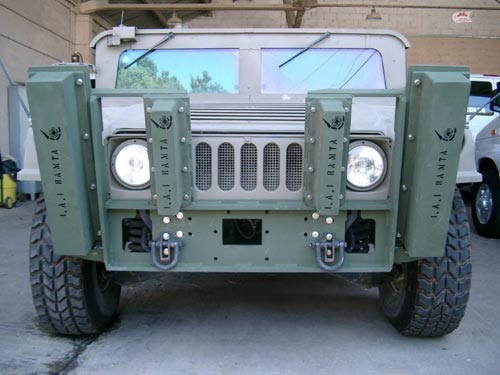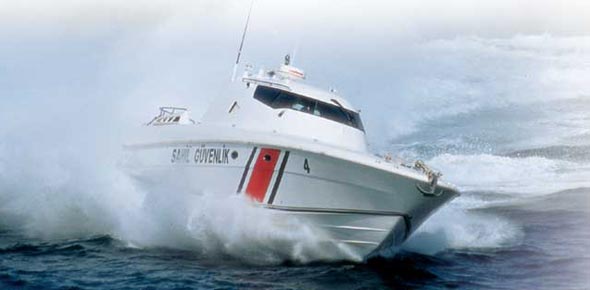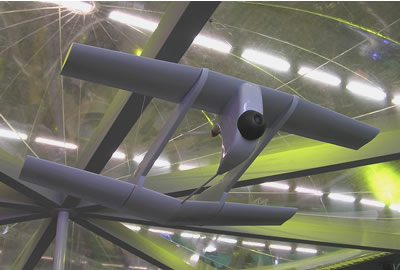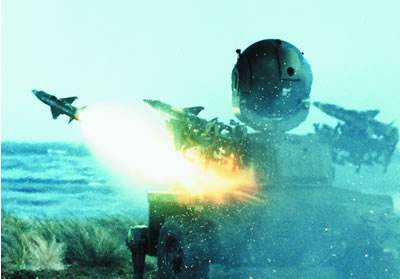Datalinks have also been optimized for small UAVs. Tadiran Spectralink’s Star Link is an ultralight communications channel, which delivers the data and video captured by the payload to a compact PC based terminal carried by a soldier. StarLink comprises integral Air Data Terminal units, Ground Data Terminals, and Air Data Relays – all in miniaturized form.
Terrier
TERRIER is jointly produced by the German Krauss-Maffai Wegman company and Iveco, from Italy, which supplies the chassis and engine. The vehicle has a large open space cabin, fitted with two side doors and a large read door for rapid dismount. Terrier is capable of comfortably accommodating 6-8 fully equipped troops. The Terrier can be used as a troop carrier, command and tactical logistic vehicle, for patrol, escort, reconnaissance and logistical support missions. The vehicle is constructed with a bullet proof (7.62×51 cal) and fragment proof protected cage, and is fitted with a floor which defeats AP mines (including the DM31 bouncing mine). Critical components such as the fuel tank and batteries are well protected. The vehicle can be equipped with a roof mounted firing hatch, where a machine gun can be mounted for self-defense. Three firing ports are also installed on each side, with additional ports at the front and rear. Fire extinguishing system is also provided for the engine and tires.
On-Board Anti-Magnetic Mine Actuating System
IAI/Ramta developed several versions of Magnetic Mine Actuating Systems which are currently operational with several armies worldwide. In 2003 the company tested the third generation of the On-Board Anti-Magnetic Mine Actuating System went through a demonstration and testing by the Israeli Army, and the US Naval Surface Warfare Center. The system detonates magnetic influenced anti-tank mines at varying distances outside the ‘kill zone’ of the mines to the front and sides of the host vehicle. Such mines can be buried by hand, or used in area tactics dispersed from helicopters, artillery cargo projectiles or cluster bombs, and cargo munitions. The anti-magnetic countermeasure system can be configured to specific vehicles, with two or four ruggedized emitters mounted on tanks, APCs or light vehicles. It can be used on finished or unfinished road surfaces, and cross country. The system also has an integrated training mode.
Advanced Optoelectronic Components For High Speed Communications Servers
Honeywell and SiOptical Inc. announced a collaboration for the development of a new opto-electronic processing and communications networking a platform, which will offer the production of cost effective optoelectronic component by the end of 2005. New Serializer / Deserializer (SerDes) components are expected to provide advanced serial architecture for military, aerospace and commercial high-speed servers of communications networking systems, and Opto-electronic Application Specific Integrated Subsystems (OASIS). Such capabilities are required to support increased data speed and bandwidth requirements.
According to Kal Shastri, SiOptical Chief Executive Officer, by “monolithically integrating optics with state-of-the-art commercial Complementary Metal Oxide Semiconductor (CMOS) technology, bring optics to the same level of integration, scalability and manufacturability as CMOS technology.” Grenville Hughes, Product Line Manager, Honeywell Defense Space & Electronic Systems expects that “next-generation communications systems to significantly exceed performance of systems with SerDes. This will result in a new, cost effective optoelectronic component by the end of 2005”. Honeywell anticipates SerDes technology being available in 2005 and OASIS technology in 2006.
SRAMS Super Rapid Advanced Mortar
Super Rapid Advanced Mortar System (SRAMS) – both 120mm mortar systems. Since the system uses along (2.5 meter) barrel, loading was a considerable challenge, which was solved by the application of an automatic muzzle loading system. This addition provides SRAMS with automatic operation and high rate of fire of up to 18 rounds per minute. To sustain such a rapid firing rate, the company developed a unique patented cooling system and a breech valve that removes trapped air from the tube and enables the bomb to fall freely into the barrel significantly reducing the loading sequence. The mortar is designed to produce low recoil forces of less than 20 tons. SRAMS weighs 2 tons and can be operated autonomously, by computer control and automatic laying which offers response time is less than 60 seconds. It fires standard or extended range munitions, to ranges of 9 to 13 km (assisted ammunition). The mortar system can be installed on lightweight chassis. It was demonstrated at Asian Aerospace 2004 mounted on a Bronco tracked utility vehicle.
Manufacturer: Singapore Technologies Kinetics (Singapore)
MRTP 15 / 27 / 33 – Fast Patrol Boats
The Multi-Role Tactical Platform (MRTP) was developed by Yonca Onuk shipyards for coastal and littoral operations. The Turkish Coast Guard is operating 12 boats since 1997, and has 12 more on order. The boats are manufactured from advanced composite materials. Utilizing a V hull, the MRTP15 can accelerate to up to 64 knots in calm water and maintain 50kt at sea state 3. The boat is operated by a crew of four, can transport up to 10 passengers or a mission payload of 2 tons, including sensors, weapons mounts and divers support equipment. Kaan 15 (photo above) utilizes twin disc, steerable ASD powered by two MTU 12V183 TE93ECU diesels. The boat can be reconfigured to perform specific missions, including search and rescue, security and patrol – with weapons packages, including electro-optically directed stabilized gun and missile turrets, and special operations and divers support. A special version of the Kaan 15 is also modified into the MRTP 15 SOC. This fast boat is designed for special operations, such as covert surveillance, long range covert insertion and recovery of special forces, anti-terrorist raids, interception and boarding of vessels, and interdiction of illegal marine activities. It is designed with a lower profile, and a specially protected keel to enable safe beaching, without damaging the hull. The boat has a redesigned rear section, can carry inflatable boats or RIBs and can be operated as a “mini mother ship, in support of naval commandos operations.
The largest member of the family is the MRTP-33, a patrol boat based on the Kaan-29, which is also operated by the Turkish Coast Guard. MRTP-33 is designed for patrol missions, and littoral warfare operations, including escort and fast attack missions, insertion and extraction of special forces. It can be fitted with CODAG high-seed propulsion system consisting of twin MTU diesels and a Honeywell TF50 gas turbine, all powering water jets. The diesels allow 28 knots patrol speed, while the gas turbine will enable the boat to reach its maximum speed of 55-60kt. The combined propulsion enables the boat to operate for up to 3 days at ranges up to 650 nm, at a speed of 24kt, while speeding on short dashes to speeds up to 55 knots. MRTP-33 has a crew of 20. Mission packages can include stabilized naval turrets with automatic guns (30mm), medium and long range guided missiles, 12.7mm machine guns, multi-sensor payloads, search and rescue equipment, decoys and special operations and divers support equipment.
Mobile User Objective System (MOUS)
Tactical Satellite Communications System
On September 24, 2004 the U.S. Navy selected a team led by Lockheed Martin, with team members General Dynamics C4 Systems, and Boeing Satellite Systems, to develop and build the Mobile User Objective System (MUOS), a next-generation narrowband tactical satellite communications system that will provide significantly improved and assured communications for the mobile warfighter.
MUOS will replace the current narrowband tactical satellite communications system known as the Ultra High Frequency Follow-On (UFO) system. MUOS satellites will be fully compatible with the existing UFO system and associated legacy terminals while dramatically increasing military communications availability and providing simultaneous voice, data and video in real time to mobile warfighters around the globe. MUOS will also maximize the full feature capability of the future Joint Tactical Radio Systems (JTRS) terminals. The initial phase is expected to cost US$ 2.1 billion, and include two satellites and associated ground control elements. The initial satellite will be deployed in space by 2010.
Under the MOUS program, the U.S. Navy Space and Naval Warfare Systems Command (SPAWAR) has provisions for three additional spacecraft at a cost of around US $1.1 billion. SPAWAR is operating on behalf of the Program Executive Office — Space Systems.
Morphing Aircraft Structures
Raytheon also develops new airframe elements for cruise missiles, which will be able to change in flight, adapting to the mission requirements, and other changes in the battle. These Morphing Aircraft Structures, developed under a DARPA program, are scheduled for testing in early 2005. Morphing capability applied to a missile would enable efficient flight at multiple speeds and altitudes without sacrificing performance as is currently the case when operating off the optimized cruise point. Exceptionally quick response to a threat and mission flexibility could mean fewer missiles are needed to destroy a target. Morphing wings is the first in a series of steps to permit a cruise missile to travel at high speeds to a target area, loiter and then move to another target area, with speed changes from 0.3 Mach to 3.0 Mach. The technology ultimately could be applied to other platforms and future air vehicles, manned and unmanned. To facilitate such morphing structures, the integrated system design probes advanced materials, actuators, sensors and electronics to create devices and adaptive structures that enable significant in-flight vehicle shape change. These shape changes are more significant than those currently found in flight vehicles, and, in turn, will enable new military capabilities such as those envisioned by Raytheon.
Merlin Mini UAV
Merlin is a lightweight electrically powered unmanned bi-plane miniature UAV, developed to support light ground forces with surveillance capability. The 1 meter long vehicle uses 1.6 meter span bi-plane wing. Its Gross takeoff Weight is 6 kg, and two-axis stabilized payload weight is 0.8kg. The operator can assemble and prepare the Merlin for a mission in five minutes. The MAV is launched by hand or sling, to a mission of over one hour, at cruising speed of 55 – 75 km/h. At the completion of the mission Merlin automatically returns to a pre-designated landing point sized 30×30 meters, where it is retrieved by a parachute. Merlin is capable of operating with three types of payloads – daylight TV with an x10 zoom, day/night payload operating an uncooled IR camera, derived from the Felin PROGRAM, and a ECCMOS-IL day/night camera which was also selected for FELIN. The datalink used by Merlin operates at a range of 7 km, at a frequency of 5 GHz.
Rapier FCS (Jernas)
JERNAS system, also known as Rapier FSC is a mobile, low altitude and point defense system designed to counter airborne threats including UAVs, and stealth cruise missiles as well as fixed and rotary wing aircraft, in all weather and extreme electronic warfare environments. The system utilizes a launcher armed with eight ready to fire Rapier Mk II missiles, and an integral electro-optical surveillance and tracking system. The unit also use a 3D surveillance radar which can handle 75 targets simultaneously, with automatic prioritization of targets for engagement. The radar tracker uses an ultra-narrow beam width to allow effective tracking under difficult conditions. The system is claimed to be effective against smart munitions and saturation attacks.
When used with the EO tracker, the radar tracker provides a dual engagement capability to improve the system’s immunity to countermeasures. Multiple launchers can be networked over a combat net radio to cover a wide area by multiple surveillance radars. JERNAS systems are deployable in a C-130 and can join maneuver forces to offer high mobility over land, to support rapid reaction forces. Two British Army air defense units and three RAF Squadrons are currently equipped with 60 Rapier FCS units, which are scheduled to remain in service at least until 2020. The system was selected the system in 2002, to equip a new air defense regiment of the Malaysian Army, scheduled for operation by 2005.
Mercury Wideband Network Radio
ITT’s Mercury Wideband Network Radio (WNR) is providing the backbone for the first two digitized divisions of the US Army and the British Army Bowman digitization program. The system operates at the 225 – 450 MHz UHF frequency band introducing a High Capacity Data radio (HCDR) which can be deployed both on the move (at speeds of up to 50 km/h) and from fixed positions, supporting intelligence, targeting, air defense and command posts as well as backbone data operations. Utilizing self-organizing networking techniques, the WNR is independent from fixed base stations and can therefore be deployed with mobile units. In a typical brigade application, the aggregate throughput of the WNR can deliver over 2 mbps, supporting multiple users at a data rate of 288 kbps per user. This capacity has already demonstrated effectively for bandwidth demanding video teleconferencing from moving vehicles. A message delivery rate of about one second per message (at an average 4 hops), operating at a maximum power of 20 watts, the WNR covers a range of 35-40 km in open terrain.
Krasnopol, Kitolov Precision Guided Artillery Munition
Krasnopol (152/155mm) and Kitolov (122mm) projectiles are fired with standard propellant charges into a ballistic trajectory. At the peak, the nose cap is ejected, and the laser seeker begins to scan the ground for laser designated targets. Krasnopol / Kitolov munitions are stowed in two separate sections – control section and projectile. Both are connected before firing when it is prepared for a mission. The system is designed to enable multiple engagements of different rounds in a small area, using several designators, as well as salvo firing by different artillery pieces, engaging a single target, illuminated by a single laser designator.
The company is also offering a laser designator for the system, which is capable of targeting a large size object at a range of 20 km. A moving tank can be targeted at a range of 5 km, or 7 km, when it is stationary. The firing range of the Krasnopol weapon is 20km, Kitolov 2M can reach 12km. Hit probability of these munitions range from 0.7 – 0.9, depending on the specific engagement conditions.
Kevlar Polyethylene Fiber
KEVLAR® is an organic, para-aramid man-made fiber technology which combines high strength with light weight, and comfort with protection. This material is five times stronger than steel on an equal weight basis, which means that it can provide more lightweight, flexible and comfortable protection than steel armor. This material has high tensile strength at low weight, structural rigidity, toughness, high resistance to chemicals and fire.


















